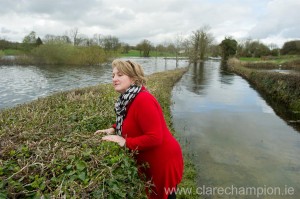- By Owen Ryan
THE effects of the extreme weather of January and February are just a memory for most people now but in one corner of Newmarket-on-Fergus parish, a number of people remain marooned in their homes because the flooding has yet to subside.
Hilary Gough, who lives in the townland of Ballycar, says the level of flooding in the area has only recently started to drop, nine weeks on from the storms that wreaked havoc across the county.
At the moment, there are four houses, one unoccupied, that are inaccessible because of flooding on either side of the approach roads. Until recently, a fifth house was also inaccessible.
Ms Gough is critical of Clare County Council’s handling of the problem, accusing them of having “never tackled the issue (flooding), despite being aware of it for years”.

“There’s a huge health and safety issue here. The council has a duty of care to the residents that they’re not fulfilling, absolutely not fulfilling,” she declared.
Clare County Council has distanced itself from any blame, pointing to the fact that flooding at Ballycar has been an ongoing problem for over 80 years.
Defending its position, the council did have some words of comfort for the Ballycar resident, stating works are to be carried out by the end of the year, if resources are available.
Ms Gough told The Clare Champion that it is only in the last week that the floodwater has begun to recede.“When they closed the Ennis-Limerick line due to the flooding at Ballycar in the first week of February, they said it would probably be open again by the middle of March. Then they said it would be April and now they predict May,” she said.
Ms Gough says the local authority put down bollards but didn’t take care to keep moving them outwards as the flood increased. She said one car went straight into the flood water.“About four weeks ago, early one Saturday morning, a car came around the corner and the bollards the council had put there had floated off.
“It was a young couple and they hit the water at speed and the car tipped onto its boot. It stayed upright for what seemed like a few minutes to them; it slowly came down and, as it did, the car flooded. They were submerged up to their necks, all the electrics were gone, everything,” she said.
“They were in quite a state of panic but he managed to find something to break a window and they came out through the window,” Ms Gough added.
“He said what had made him break the window was that the car started to drift. The hedge beside the road was completely submerged and the car probably would have gone over it and sunk.”
Locals have now taken it on themselves to move the bollards to reflect changes in the level of the floodwater.
Ms Gough’s own children go out on kayaks, so deep is the water. Her house no longer has heating oil and fuel for the fireplaces has to be carried in by hand, on a cross-country route through neighbour’s property, as do all their groceries.
It would be extremely difficult for emergency services to reach her home, she maintained. “We’re cut off to the fire brigade, we’re cut off to ambulances; we actually have a pump and some hoses from the fire station in Shannon in our garage for the last eight weeks. That’s in our garage because they’ve told us they can’t access us and if one of us became sick, we’d have to be taken out by helicopter.”
The official response to the long-standing flooding has left her disappointed.
“There’s a huge health and safety issue here. The council has a duty of care to the residents that they’re not fulfilling, absolutely not fulfilling. We’re paying our property tax, paying our car tax, we have no access to the road and there’s no interest from them. There’s no one knocking on our door to see how we are getting on.”
Almost 20 years ago, flooding in the area was almost as bad but she says the local authority still granted planning permission for most of the houses affected subsequent to that.
She believes that with the local authority having knowledge of the Ballycar situation for so long, the floods of this spring should have been prevented.
“It rose to this level in 1995 and then there was a committee put together from the council, local residents, experts etc and there were great promises made that it would be resolved but it’s still not resolved. It is a recurring problem; it’s not like what happened in Lahinch, it’s not a freak of nature, a one-off. This is a recurring problem that the council know about.”
She said local people have a good knowledge of the problem, from whom the council should take guidance.
For a number of years there has been debate about which State body should take responsibility for the flooding, with no resolution.
While relief from flooding would undoubtedly bring benefits for Iarnród Éireann, she said the council has a responsibility to those living in the area. “My response is that it doesn’t affect me if that train never runs. The most important thing for the council is that we can’t access our houses via their road. Whether the railway runs or not, they need to make sure their road is open,” she stressed.
Owen Ryan has been a journalist with the Clare Champion since 2007, having previously worked with a number of other publications in Limerick, Cork and Galway. His first book will be published in December 2024.




